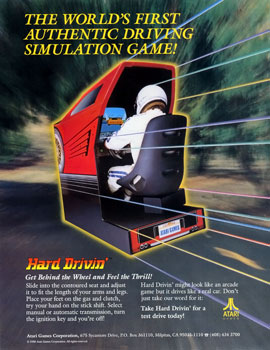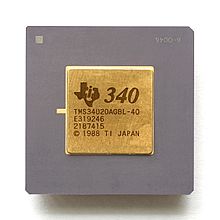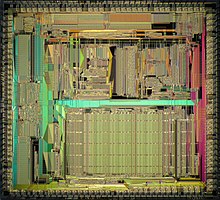
IBM 8514 is a graphics card manufactured by IBM and introduced with the IBM PS/2 line of personal computers in 1987. It supports a display resolution of 1024 × 768 pixels with 256 colors at 43.5 Hz (interlaced), or 640 × 480 at 60 Hz (non-interlaced). 8514 usually refers to the display controller hardware. However, IBM sold the companion CRT monitor which carries the same designation, 8514.
The Atari Transputer Workstation is a workstation class computer released by Atari Corporation in the late 1980s, based on the INMOS transputer. It was introduced in 1987 as the Abaq, but the name was changed before sales began. Sales were almost non-existent, and the product was canceled after only a few hundred units had been produced.
A blitter is a circuit, sometimes as a coprocessor or a logic block on a microprocessor, dedicated to the rapid movement and modification of data within a computer's memory. A blitter can copy large quantities of data from one memory area to another relatively quickly, and in parallel with the CPU, while freeing up the CPU's more complex capabilities for other operations. A typical use for a blitter is the movement of a bitmap, such as windows and icons in a graphical user interface or images and backgrounds in a 2D video game. The name comes from the bit blit operation of the 1973 Xerox Alto, which stands for bit-block transfer. A blit operation is more than a memory copy, because it can involve data that's not byte aligned, handling transparent pixels, and various ways of combining the source and destination data.

A graphics processing unit (GPU) is a specialized electronic circuit initially designed to accelerate computer graphics and image processing. After their initial design, GPUs were found to be useful for non-graphic calculations involving embarrassingly parallel problems due to their parallel structure. Other non-graphical uses include the training of neural networks and cryptocurrency mining.

Mortal Kombat 4 is a 1997 fighting game, the fourth main installment in the Mortal Kombat franchise, and a sequel to 1995's Mortal Kombat 3. It was developed by Midway Games. Released to arcades in 1997, Mortal Kombat 4 is the first title in the series, and one of the first made by Midway overall, to use 3D computer graphics. It is also the last game of the series to have an arcade release. It was ported to the PlayStation, Nintendo 64, PC, and Game Boy Color in 1998. An updated version titled Mortal Kombat Gold was released exclusively for the Dreamcast.

The X68000 is a home computer created by Sharp Corporation. It was first released in 1987 and sold only in Japan.

Texas Instruments Graphics Architecture (TIGA) is a graphics interface standard created by Texas Instruments that defined the software interface to graphics processors. Using this standard, any software written for TIGA should work correctly on a TIGA-compliant graphics interface card.

Mortal Kombat II is a fighting game originally produced by Midway for the arcades in 1993. It was ported to multiple home systems, including MS-DOS, Amiga, Game Boy, Game Gear, Sega Genesis, 32X, Sega Saturn, Super Nintendo Entertainment System, and PlayStation only in Japan, mostly in licensed versions developed by Probe Software and Sculptured Software and published by Acclaim Entertainment.
The following article is a broad timeline of arcade video games.

Narc is a 1988 run and gun arcade game designed by Eugene Jarvis for Williams Electronics and programmed by George Petro, Todd Allen, and Eugene Jarvis, with art by Jack Haeger, John Newcomer, and Lin Young. It was one of the first ultra-violent video games and a frequent target of parental criticism of the video game industry. The object is to arrest and kill drug offenders, confiscate their money and drugs, and defeat "Mr. Big". It was the first game in the newly restarted Williams Electronics coin-op video game division. Shortly before its release, Williams acquired the video and pinball divisions of Bally/Midway.

Total Carnage is a multidirectional shooter arcade video game originally developed and published by Midway in North America in January 1992. Set in the fictional country of Kookistan during 1999, players assume the role of Captain Carnage and Major Mayhem from the Doomsday Squad in a last-ditch effort to overthrow dictator General Akhboob and his army of mutants from conquering the world, while also rescuing POWs held by his military force.

A video display controller (VDC), also called a display engine or display interface, is an integrated circuit which is the main component in a video-signal generator, a device responsible for the production of a TV video signal in a computing or game system. Some VDCs also generate an audio signal, but that is not their main function. VDCs were used in the home computers of the 1980s and also in some early video picture systems.

The R3000 is a 32-bit RISC microprocessor chipset developed by MIPS Computer Systems that implemented the MIPS I instruction set architecture (ISA). Introduced in June 1988, it was the second MIPS implementation, succeeding the R2000 as the flagship MIPS microprocessor. It operated at 20, 25 and 33.33 MHz.
Digital Compression System, or DCS, is a sound system developed by Williams Electronics. This advanced sound board was used in Williams and Bally pinball games, coin-op arcade video games by Midway Manufacturing, and mechanical and video slot machines by Williams Gaming. This sound system became the standard for these game platforms.
The Midway T Unit is an arcade system board designed by Midway and successor to the Midway Y Unit.

Hard Drivin' is a sim racing arcade video game developed by Atari Games in 1989. Players test drive a sports car on courses that emphasize stunts and speed. It features one of the first 3D polygon driving environments via a simulator cabinet with a haptic vibrating steering wheel and a custom rendering architecture.
Transform, clipping, and lighting is a term used in computer graphics.

Computer graphics deals with by generating images and art with the aid of computers. Today, computer graphics is a core technology in digital photography, film, video games, digital art, cell phone and computer displays, and many specialized applications. A great deal of specialized hardware and software has been developed, with the displays of most devices being driven by computer graphics hardware. It is a vast and recently developed area of computer science. The phrase was coined in 1960 by computer graphics researchers Verne Hudson and William Fetter of Boeing. It is often abbreviated as CG, or typically in the context of film as computer generated imagery (CGI). The non-artistic aspects of computer graphics are the subject of computer science research.

Mortal Kombat is a 1992 fighting game developed and published by Midway. It is the first entry in the Mortal Kombat series and was subsequently released by Acclaim Entertainment for nearly every home platform at that time. The game focuses on several characters of various intentions who enter a martial arts tournament with worldly consequences. It introduced many key aspects of the Mortal Kombat series, including the unique five-button control scheme and gory finishing moves called Fatalities.

Race Drivin' is a driving arcade game originally released by Atari Games in 1990. Players must test drive several high-powered sports cars on stunt and speed courses. The game is the sequel to 1989's Hard Drivin' and was part of a new generation of games that featured 3D polygon environments. Unlike most racing games of its time, it attempted to model real world car physics in the simulation of the movement of the player's car. Like Hard Drivin', the game is unique among video games in that it includes a true force feedback steering wheel, an ignition key, a four-speed shifter, and three foot pedals: an accelerator, a brake, and a clutch. Released in August 1990, approximately 1200 units were produced at the time of its release for roughly US$9,000 each.















